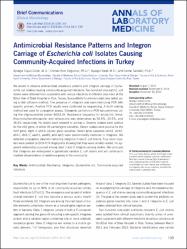Antimicrobial resistance patterns and integron carriage of escherichia coli isolates causing community-acquired infections in Turkey
Citation
Cicek, A.C., Ozgumus, O.B., Saral, A., Sandalli, C., (2014). Antimicrobial Resistance Patterns and Integron Carriage of Escherichia coli Isolates Causing Community-Acquired Infections in Turkey. Annals of Laboratory Medicine, 34(2), 139-144. https://doi.org/10.3343/alm.2014.34.2.139Abstract
We aimed to observe antimiCrobial resistance patterns and integron carriage of Escherichia coli isolates causing community-acquired infections. Two hundred sixty-eight E. coli strains were obtained from outpatients with various infections at different polyclinics at the 82nd Year of State Hospital in Rize, Turkey. Susceptibility to antimicrobials was tested using a disk diffusion method. the presence of integrons was examined using PCR with specific primers. Positive PCR results were confirmed by sequencing. A broth mating method was used for conjugation assays. Extragenic palindromic-FOR was performed using the oligonucleotide primer BOXA1R. Resistance frequency for ampicillin,trimethoprim/sulfamethoxazole, and tetracycline was determined as 50.6%, 33.5%, and 36.8% respectively. No strains were resistant to amikacin. Seventy isolates were positive for the intll gene, of which 49 carried gene cassettes. Eleven isolates were positive for the int12 gene, eight of swhich carried gene cassettes. Seven gene cassettes (dfrAl, dfrA5, dfrA7, dfrA17, aadAl, aadA5, and sat2) were predominantly harbored in integrons. We detected conjugative plasmids harboring integrons in two E. coli strains. Four strain clusters were yielded by BOX-FOR fingerprints showing that they were clonally related. No apparent relationship occurred among class 1 and 2 integron-carrying strains. We conclude that integrons are widespread in genetically variable E. coli strains and will continue to mediate dissemination of resistance genes in the community.We aimed to observe antimiCrobial resistance patterns and integron carriage of Escherichia coli isolates causing community-acquired infections. Two hundred sixty-eight E. coli strains were obtained from outpatients with various infections at different polyclinics at the 82nd Year of State Hospital in Rize, Turkey. Susceptibility to antimicrobials was tested using a disk diffusion method. the presence of integrons was examined using PCR with specific primers. Positive PCR results were confirmed by sequencing. A broth mating method was used for conjugation assays. Extragenic palindromic-FOR was performed using the oligonucleotide primer BOXA1R. Resistance frequency for ampicillin, trimethoprim/sulfamethoxazole, and tetracycline was determined as 50.6%, 33.5%, and 36.8% respectively. No strains were resistant to amikacin. Seventy isolates were positive for the intll gene, of which 49 carried gene cassettes. Eleven isolates were positive for the int12 gene, eight of swhich carried gene cassettes. Seven gene cassettes (dfrAl, dfrA5, dfrA7, dfrA17, aadAl, aadA5, and sat2) were predominantly harbored in integrons. We detected conjugative plasmids harboring integrons in two E. coli strains. Four strain clusters were yielded by BOX-FOR fingerprints showing that they were clonally related. No apparent relationship occurred among class 1 and 2 integron-carrying strains. We conclude that integrons are widespread in genetically variable E. coli strains and will continue to mediate dissemination of resistance genes in the community.


















